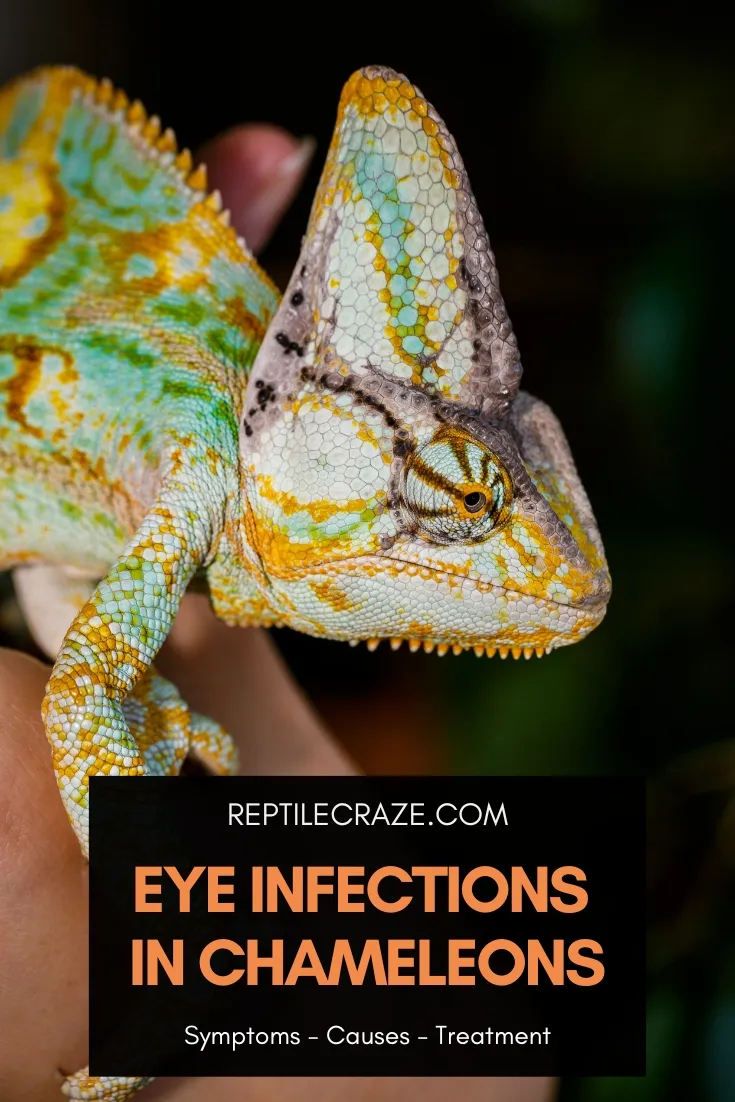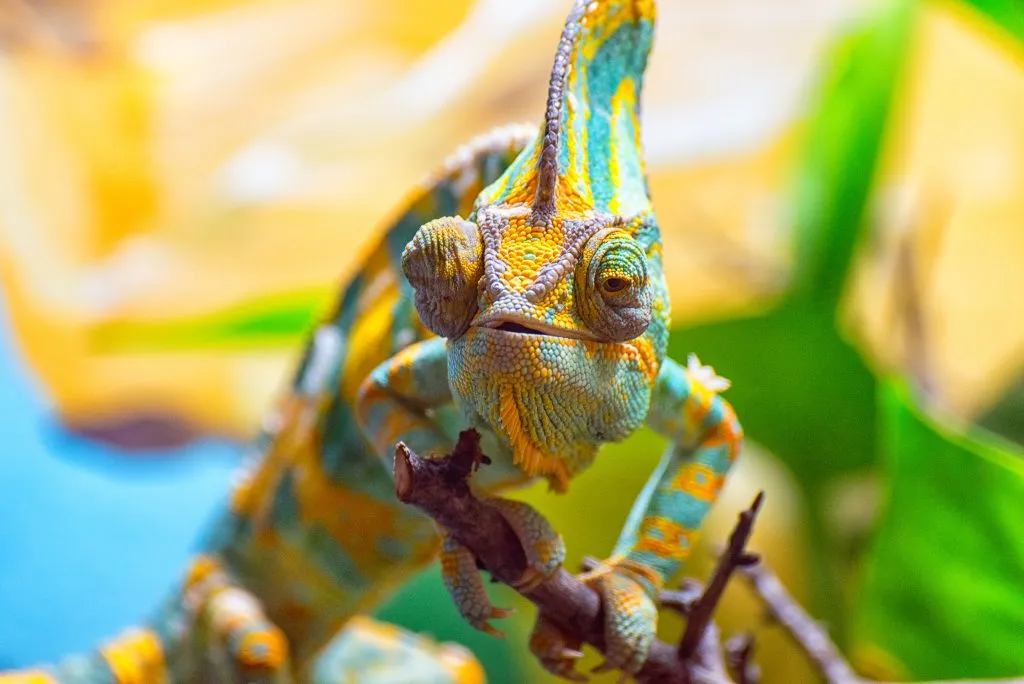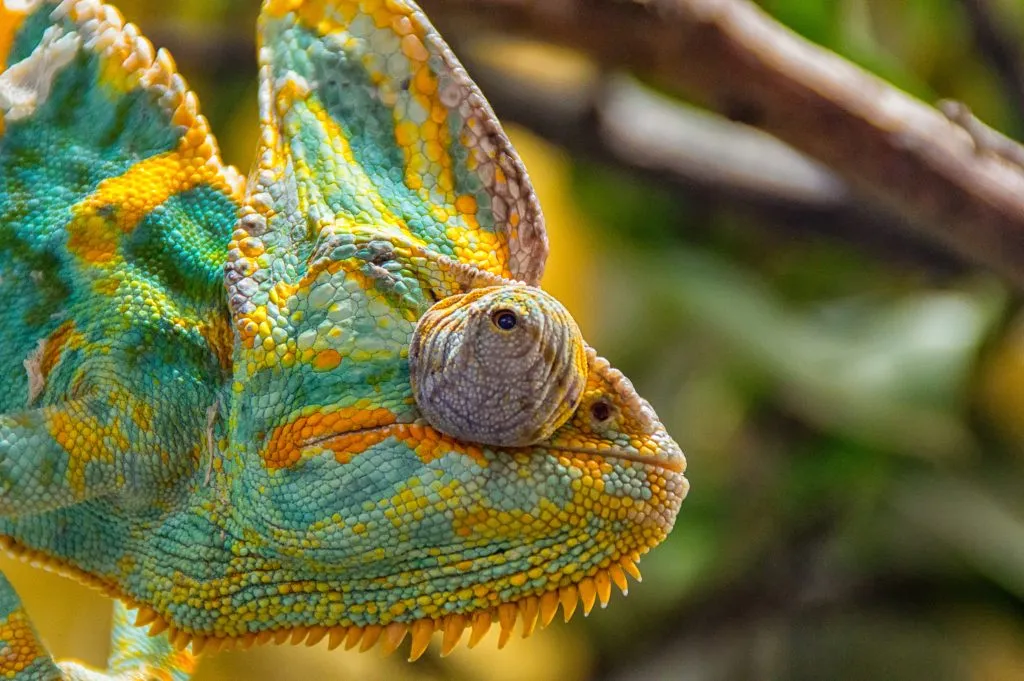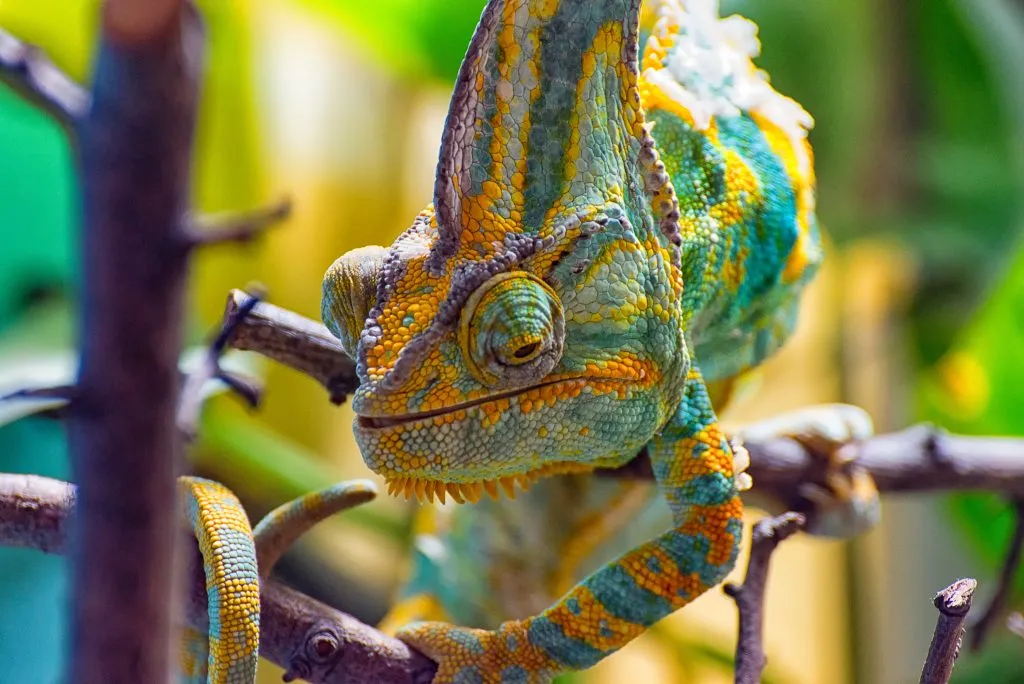
Chameleons are fascinating creatures with unique eye features and powerful vision that help them with catching their prey. Unfortunately, chameleons, like most other reptiles, are susceptible to eye infections that can lead to severe health issues if left untreated.
Eye infections in chameleons can be caused by bacterial, viral, and parasitic diseases. Often, however, management-related issues like vitamin A deficiency, environmental irritation, poor ventilation and humidity, and foreign objects affect the eyes first, making them susceptible to infection.
In this article, we will explore the symptoms, causes, and treatment of eye infections in chameleons. We will also provide some tips on how to prevent eye infections from occurring.
Table of Contents
Symptoms of Eye Infections in Chameleons
Common symptoms of eye infection or ocular disease in chameleons can involve some or the whole structure of the eye itself (the globe), as well as the surrounding parts.
The surrounding part, or ocular adnexa, includes the eyelids, the conjunctiva, or the underside surface of the eyelids that touch the globe.
Also, the nasolacrimal duct, which connects to the roof of the mouth, and the tear glands.
Eye infection can involve one or many of these ocular structures, and symptoms can vary according to the area affected and the cause of the disease. The common signs of eye infection in chameleons are:
- Swollen or puffy eyes: Chameleons with eye infections may have one or both eyes that appear swollen or puffy. The puffiness is usually because of the inflammation or edema of the conjunctiva.
- Difficulty opening the eyes: When the eyes are involuntarily closed, this is usually a sign of pain and discomfort. Often, the cause is due to irritation from environmental factors or foreign objects that may have entered the eye.
- Cloudy eyes: Healthy eyes are clear and bright. However, infection and scarring of tissues can cause the eyes to lose opacity. The cloudiness can lead to decreased visual acuity, which can have negative effects on your chameleon’s movement and behavior.
- Discharge: Eye infections can cause discharge, which may appear as clear, white, or yellowish liquid. Discharge can accumulate around the eye and cause crusting or stickiness, which may make it difficult for the chameleon to open or close their eyes.
- Abscess: Abscesses are also pretty common in chameleons. They appear as a tender, painful mass of bacteria and pus, usually on the eyelids. Abscesses are usually caused by infectious agents or vitamin A deficiency.
- Prolapse: In some cases, the eyes may bulge out. This may be caused by the enlargement of the eye due to inflammation, or the weakening of the bones around the eyes caused by metabolic bone disease.
- Sunken eyes: Sunken eyes usually serve as a warning sign that your chameleon is ill. Sunken eyes are typically accompanied by other symptoms such as a lack of appetite, dehydration, and weight loss.
- Changes in behavior: Chameleons with eye infections may be lethargic or lack appetite. They tend to hide, avoid light, or become more aggressive when handled. They can show signs of discomfort and irritation by cage rubbing or clawing at the eyes.
Causes of Eye Infections in Chameleons
Eye infections in chameleons can be caused primarily by infectious agents themselves. More often than not, however, eye infection comes secondary to non-infectious factors that are a result of poor husbandry and management.
Infectious Agents
Infectious agents that cause eye infections in chameleons are usually of bacterial, viral, or parasitic origin. Viruses such as herpesvirus and iridovirus are known to infect the reptilian eye.
A parasitic worm known as Foloyella, although rare, can infect the eyelids of chameleons and cause swelling.
A common bacteria known as Pseudomonas has been reported to cause ocular abscess in a three-horned chameleon.
However, bacterial eye infections are pretty uncommon, so it can be alarming when they occur because this may be a manifestation of septicemia or a bacterial infection of the blood.
Vitamin A Deficiency
Being insectivorous lizards, chameleons are susceptible to vitamin A deficiency.
Because vitamin A is responsible for the normal turnover of epithelial tissues, a lack of vitamin A causes eye problems in chameleons. The buildup of cells leads to swollen and closed eyelids, abscess and discharge.
Foreign Bodies and Environmental Irritants

Items in your chameleon’s enclosure can be irritating to the eyes. For example, loose substrates such as sand and sawdust are very particulate, so they can easily enter the eyes, scratch at the corneal surface, and cause injury.
Some tropical plants that are often used to decorate chameleon habitats, such as Ficus and Pothos species, contain oxalates on the surface of their leaves.
Excess buildup of oxalates can cause eye irritation to chameleons when they come in contact with the leaves.
Poor Ventilation and Humidity
Rainforests are the natural habitat of most chameleons. As such, they are used to living in high humidity and high ventilation areas.
When these are not met, eye problems can occur, usually starting with swelling of the eyes.
How To Treat Eye Infections In Chameleons
If your chameleon is exhibiting symptoms of an eye infection, it’s essential to seek veterinary care as soon as possible.
Your vet will ask for a detailed history of your chameleon, especially information related to care and management.
The herp vet will proceed to physically examine your chameleon to look for lesions and abnormal features that will suggest disease.
When an eye infection is suspected, they will typically recommend running some tests to confirm the diagnosis.

Veterinary testing for eye diseases includes checking and identifying the presence of bacterial infection, assessing the eyes’ ability to produce tears, determining the extent of eye injury, and taking blood tests to confirm if there is a problem anywhere else in the body.
Proper diagnosis allows your vet to make the best recommendations for treatment. Treatment for eye infections in chameleons may include:
- Antibiotics are prescribed to treat bacterial eye infections, yet are also used for non-infectious conditions to prevent complications. Antibiotics are usually given as topical eye drops, but in severe cases, your vet may opt to inject them to provide a systemic effect.
- Anti-inflammatory medication is given to help reduce pain and inflammation associated with eye infections. This can help your chameleon feel more comfortable, improve their appetite, and restore some of their normal behavior.
- Flushing and drainage are performed when there is a foreign object irritating the eyes, obstruction in the nasolacrimal duct or tear gland, or an abscess. Flushing and drainage provide relief and improve recovery.
- Surgery may eventually be necessary to treat severe eye infections or complications, such as in severe abscesses when debridement is needed, and in cases when your vet believes it is better to have the eye removed entirely (enucleation).
Throughout treatment, it is crucial to follow your veterinarian’s instructions in administering medication and changing aspects of your chameleon’s husbandry.
With prompt veterinary care and appropriate treatment, most chameleons can recover from eye infections and regain their health and vitality.
How To Flush Your Chameleon’s Eyes
The first aid to address eye irritation caused by foreign objects is to perform an eye flush to rinse out the debris.
Flushing helps relieve conjunctivitis caused by trapped particles that are scratching the surface and it provides temporary relief when you are unable to immediately pay a visit to the vet.
This eye rinse solution for reptiles can be used for flushing. Fill up a sterile syringe (without the needle attached) with the solution.
Your chameleon should be positioned with the head facing the ground to allow the excess fluid to drain out and downwards, preventing any accidental swallowing.
Aim the syringe at the affected eye and gently press to allow the eye rinse solution to flush through the eyes. This will help wash out foreign debris and provide temporary lubrication.
Did you know that chameleons also have a natural way to flush their eyes in the wild? They try to get rid of ocular debris by drinking excessive water during rain showers. This allows them to flush water out from the mouth, through the nasolacrimal duct, and out into the conjunctival sac.
You can help replicate this self-flushing mechanism in your chameleons by placing them under a water source such as a shower, sprinkler, or outside during the rain.
As they self-flush, you can see their eyes bulge outward and rotate.
Tip: If you would like to know how to make your chameleon drink water, read our article on that here!
How To Prevent Eye Infections In Chameleons
Preventing eye infections in chameleons is always better than treating them. As a responsible chameleon owner, taking proactive measures to minimize the risk of eye infections in your pet goes a long way.
Here are some tips to help prevent eye infections in chameleons:
Keep the Enclosure Clean
A clean and sanitary environment is essential for preventing eye infections in chameleons.
Regularly cleaning the enclosure and removing any debris, feces, or other waste that may harbor bacteria or other pathogens can go a long way in preventing infections.
Make sure you use this reptile-safe disinfectant to clean the enclosure and any accessories or decor inside.
Maintain Adequate Ventilation and Humidity
Most chameleons require a high level of humidity in their enclosure, at around 70-80%. A humidity that is too low may dry out your chameleon’s eyes and predispose them to infection.
Regularly misting the enclosure can help in maintaining high humidity levels.
Although most reptile owners keep their pets in glass aquaria, the glass material is actually a poor substrate for ventilation.
Consider housing your chameleon in a screen cage (like this one), which promotes better ventilation.
Provide a Balanced and Supplemental Diet

A chameleon’s general health and immune system function are both crucial for avoiding eye infections, so it is important to provide proper nutrition.
For your chameleon to get all the nutrients they require, they should eat a range of gut-loaded insect and plant-based foods as part of a balanced diet.
Because chameleons are prone to getting vitamin A deficiency, it helps to regularly dust their
Remove Environmental Irritants
Identify materials in your chameleon’s enclosure that may be potential irritants. Avoid using loose particles like sand and sawdust as substrates, and opt for ones that are more compact (like this one) and offer high humidity.
Misting tropical plants like Ficus and Pothos several times each day can help reduce the buildup of oxalates on the leaves.
Regular Checkups for Preventive Care
While it’s great to see your chameleon doing well and staying healthy, regular visits to the vet (at least once or twice a year) are recommended to monitor your chameleon’s health status throughout their life.
Your vet may recommend giving regular antiparasitics to prevent worms, mites, and other parasite infections.
- Enchi Ball Python: A Unique and Stunning Morph of Python regius - March 27, 2025
- Emerald Tree Monitor: The Enigmatic Green Guardian of the Rainforest - March 26, 2025
- The Egyptian Cobra (Naja haje): A Fascinating Serpent - March 25, 2025
